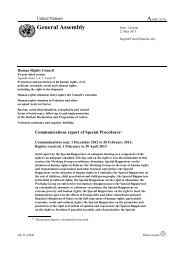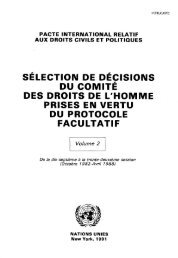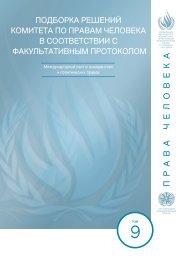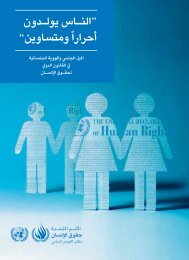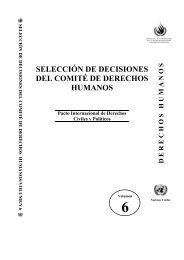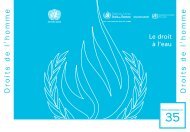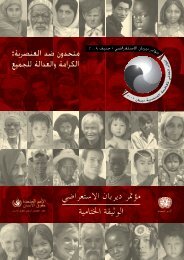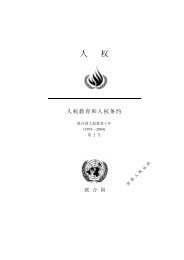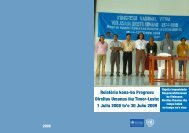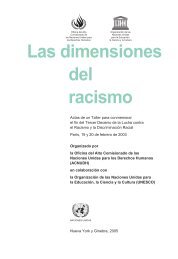good governance practices for the protection of human rights
good governance practices for the protection of human rights
good governance practices for the protection of human rights
Create successful ePaper yourself
Turn your PDF publications into a flip-book with our unique Google optimized e-Paper software.
ticipants discussed an abstract framework regarding <strong>the</strong> causes and manifestation<br />
<strong>of</strong> corruption. These two steps were designed to encourage <strong>the</strong> participants to<br />
analyse <strong>the</strong> problem <strong>of</strong> corruption dispassionately. Finally, participants engaged<br />
in self-diagnosis and self-prescription. The workshops drew on <strong>the</strong> knowledge<br />
and expertise <strong>of</strong> <strong>the</strong> employees to identify systemic problems. Employees <strong>of</strong>ten<br />
shared in<strong>for</strong>mation about corrupt <strong>practices</strong> even in cases where <strong>the</strong>ir intimate<br />
knowledge <strong>of</strong> <strong>the</strong> facts was incriminating.<br />
An ef<strong>for</strong>t was also made to rely on public input to determine <strong>the</strong> extent <strong>of</strong><br />
corruption. For example, polls were conducted to identify citizens’ priorities<br />
<strong>for</strong> public works. The polls found significant differences between <strong>the</strong> public’s<br />
priorities and <strong>the</strong> recommendations <strong>of</strong> municipal staff. Often, <strong>the</strong> staff suggested<br />
public works in sparsely populated areas, which would facilitate <strong>the</strong> construction<br />
<strong>of</strong> new buildings ra<strong>the</strong>r than provide services to existing neighbourhoods. Thus,<br />
it became evident that municipal personnel had <strong>the</strong>ir own agenda motivated by<br />
<strong>the</strong> interests <strong>of</strong> private construction and development companies. Similar polls<br />
were conducted on a number <strong>of</strong> o<strong>the</strong>r municipal policies.<br />
Following <strong>the</strong> above diagnostic work and public input, <strong>the</strong> municipality also<br />
sought to secure international funding to be able to raise <strong>the</strong> salaries <strong>of</strong><br />
employees and to invest in development projects.<br />
Implementation<br />
The anti-corruption ef<strong>for</strong>ts <strong>of</strong> La Paz’s municipal leadership included several<br />
areas <strong>of</strong> municipal government. First, <strong>the</strong> process <strong>of</strong> issuing construction permits<br />
and licences was deregulated. Also, <strong>the</strong> system through which citizens applied<br />
<strong>for</strong> permits was re<strong>for</strong>med. A single registry was set up <strong>for</strong> all applications <strong>for</strong> permits<br />
and licences. It was staffed by employees who were not involved in granting<br />
permits and licences. Fur<strong>the</strong>rmore, to increase transparency, a manual was printed<br />
and widely distributed to in<strong>for</strong>m <strong>the</strong> public about how much building permits<br />
cost, how to request services, which agency was responsible <strong>for</strong> what service and<br />
how long it would take to deliver <strong>the</strong> service.<br />
Second, an ef<strong>for</strong>t was made to reduce corruption in <strong>the</strong> municipality’s <strong>of</strong>fice <strong>of</strong> public<br />
works, which employed 4,000 workers and from which machinery, spare parts<br />
and petrol were routinely stolen. The responsibility <strong>of</strong> this <strong>of</strong>fice was changed to<br />
carrying out emergency repairs, but not major construction projects. Major public<br />
works were contracted out under an incentive-based process that linked payments<br />
to targets and <strong>the</strong> satisfactory completion <strong>of</strong> projects. The <strong>of</strong>fice <strong>of</strong> public works<br />
was re<strong>for</strong>med into a regulator which operated under this incentive-based process.<br />
Third, a number <strong>of</strong> anti-corruption initiatives helped to simplify <strong>the</strong> tax code,<br />
cutting <strong>the</strong> number <strong>of</strong> taxes from 126 to 7, to restrict opportunities <strong>for</strong> collusion<br />
between tax collectors and property owners, to hire young Bolivians in municipal<br />
service and to raise salaries through international assistance. Also, throughout<br />
this ef<strong>for</strong>t, <strong>the</strong> municipal leadership reported to <strong>the</strong> public on progress made<br />
in reducing corruption.<br />
72



